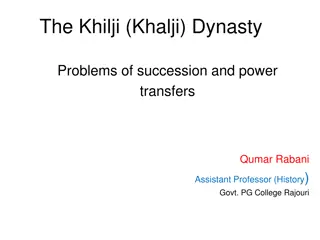Political History of Medieval India - Alauddin Khilji
Alauddin Khilji, a powerful Sultan of the Khilji dynasty, implemented strict economic policies and conducted military campaigns to expand his empire in medieval India. His rule was marked by centralized control over taxation and price regulation, along with successful conquests of various regions.
Download Presentation

Please find below an Image/Link to download the presentation.
The content on the website is provided AS IS for your information and personal use only. It may not be sold, licensed, or shared on other websites without obtaining consent from the author.If you encounter any issues during the download, it is possible that the publisher has removed the file from their server.
You are allowed to download the files provided on this website for personal or commercial use, subject to the condition that they are used lawfully. All files are the property of their respective owners.
The content on the website is provided AS IS for your information and personal use only. It may not be sold, licensed, or shared on other websites without obtaining consent from the author.
E N D
Presentation Transcript
Dissemination of Education for Knowledge, Science and Culture Shri Swami Vivekanand Shikshan Sanstha, Kolhapur Sanchlit Padmabhushan Dr.Vasantraodada Patil Mahavidyalaya, Tasgaon DEPARTMENT OF HISTORY T.Y. B.A. 8th July 2019 -Shikshanmaharshi Dr. Bapuji Salunkhe Paper No. VIII Political History of Medieval India By Dr. H.D. Nadaf Head, Department of History 2019-2020
Alauddin Alauddin Khilji Alauddin Khilji, who was the nephew and son-in-law of Jalal-ud-din was one of the most ambitious and powerful sultans of Khilji dynasty. He wanted to conquer the world (to become second Alexander). Khilji: : Alauddin Khilji, when became sultan, gave presents (of gold) to the citizens. At the same time, he also contended that he was a strong and powerful ruler and hence, he would deal severely with anyone who showed signs of disloyalty. Alauddin Khilji raised the land taxes on the wealthier people of the Doab (the fertile area between the Ganga and Yamuna rivers). Further, he strictly monitored the revenue, which the nobles got from their land and hence, did not allow them to keep anything, which was not their due. The prices of goods were also closely controlled so that everyone could afford to pay the price demanded as well as no one could make a large profit.
Alauddin Khilji made a new policy i.e. he ordered a new assessment of the cultivated land and the revenue. First, the land under cultivation (of his kingdom) was measured. And the revenue of these lands was assessed on the basis of the measurement. Alauddin Khilji campaigned against the kingdoms of Gujarat and Malwa. He tried to establish his control over Rajasthan by capturing the famous forts of Ranthambhor and Chittor. Under the command of Malik Kafur, Ala-ud-din sent a large army towards the south with the intention to conquer the peninsula as well as obtain money and wealth. Malik Kafur plundered in all directions and collected a large amount of gold from the various kingdoms of the south, including the Yadavas (of Devagiri), the Kakatiyas (of Warangal), and the Hoyasalas (of Dvarasamudra).
The defeated rulers were allowed to keep their throne provided they paid a tribute. Malik Kafur also conquered the city of Madurai. By the time, no north Indian ruler attempted to penetrate so far in the south India. In 1,315, Aladdin Khilji died. After his death, there was a chaotic situation for the succession. Ambitious Malik Kafur made himself as sultan, but lacked support from Muslim amirs and hence, he was killed only after few months. By 1,320, three more Khilji successors assumed power, but no one sustained rather killed brutally. Likewise, a new dynasty namely Tughlaq was founded. Medieval Indian History 20 Tughlaq dynasty came after the Khilji dynasty and ruled from A.D. 1320 to 1413.
ThankYou Thank You























